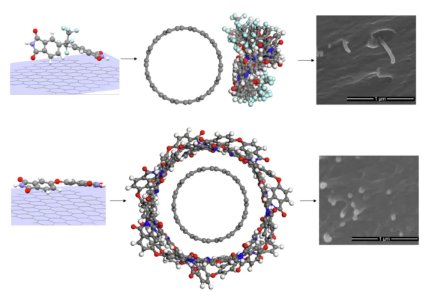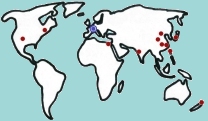Veröffentlichungen
Nach Erscheinungsjahr...
| 2016-2018 | 2019-2021 | 2022-2024 | 2025 |
| 2004-2006 | 2007-2009 | 2010-2012 | 2013-2015 |
| bis 1990 | 1991-1995 | 1996-2000 | 2001-2003 |
... oder nutzen Sie die
Neueste Veröffentlichungen
The size of critical secondary nuclei of polymer crystals does not depend on supersaturation
Yang Liu, Zhiqi Wang, Yao Zhang, Tianyu Wu, Tianze Zheng, Bao Hua Guo, Günter Reiter, Jun Xu. Nature Communications 16 (2025) 3773
It is still a great challenge to determine the size of critical nuclei, which is crucial for a comprehensive understanding of crystallization and for testing the controversial crystallization theories. Here, we propose a method to determine the size of critical secondary nuclei on growth faces of poly(butylene succinate) single crystals in solution, basing on the probability of statistically selecting crystallizable units in random copolymers. In a dilute solution and for a given crystallization temperature, we reveal that the size of critical secondary nuclei was independent of supersaturation, contrary to the well-accepted prediction of existing theories which expect that the size of the critical nucleus increases with decreasing supersaturation. Accounting correctly for the dilution-caused change in the steady-state concentration of clusters of various sizes, we remedy inconsistencies of existing theoretical approaches in deriving the correct size of critical secondary nuclei in solution being independent of supersaturation. (more...)
Binghua Wang, Hailong Zou, Xuchen Wang, Changyu Shen, Jingbo Chen, Günter Reiter, Bin Zhang. Nature Communications 16 (2025) 3275
The dissolution of polymer crystals often proceeds at rates varying in time and space. Here, using low molecular weight poly(ethylene oxide) as a model polymer, we exploit step-wise selective dissolution for unveiling how spatial variations in metastability are generated during the growth of lamellar polymer single crystals. The dissolution velocity along defined crystal faces is constant, but ca. 5 times faster for rough than for smooth faces. From the temperature dependence of dissolution, we derive detachment energies of 420 ± 40 kJ/mol and 650 ± 50 kJ/mol for rough and smooth faces, respectively, suggesting that on a rough face polymer chains have ca. 1/3 less neighboring molecules to interact with. The observed high values of the activation energy indicate that, for dissolving a polymer crystal, the progressive detachment of whole chains is indispensable. Our study reveals a strong relation between growth kinetics and the resulting metastability of polymer crystals. (more...)
Baode Zhang, Snežana D. Zarić, Sonja S. Zrilić, Iosif Gofman, Barbara Heck, Günter Reiter. Communications Chemistry 8 (2025) 21
 The interplay between attractive London dispersion forces and steric effects due to repulsive forces resulting from the Pauli principle often determines the geometry and stability of nanostructures. Aromatic polyimides (PI) and carbon nanotubes (CNT) were chosen as building blocks as two components in the hetero delocalized electron nanostructures. Two PIs, having the same diamine part and different linkage substituents between two phenyl rings of dianhydride part, one linked with ether bond (C-O-C) (OPI), the other with C-(CF3)2 (FPI), were investigated. Surprisingly, two CNT/PI nanocomposites show distinct failure mode from CNT yielding to CNT pull-out failure. Calculation of the interaction energy and chain conformations of each PI upon CNT was performed by accurate density functional theory (DFT) calculations and molecular dynamic simulation (MDS). (more...)
The interplay between attractive London dispersion forces and steric effects due to repulsive forces resulting from the Pauli principle often determines the geometry and stability of nanostructures. Aromatic polyimides (PI) and carbon nanotubes (CNT) were chosen as building blocks as two components in the hetero delocalized electron nanostructures. Two PIs, having the same diamine part and different linkage substituents between two phenyl rings of dianhydride part, one linked with ether bond (C-O-C) (OPI), the other with C-(CF3)2 (FPI), were investigated. Surprisingly, two CNT/PI nanocomposites show distinct failure mode from CNT yielding to CNT pull-out failure. Calculation of the interaction energy and chain conformations of each PI upon CNT was performed by accurate density functional theory (DFT) calculations and molecular dynamic simulation (MDS). (more...)
Valentina Pirela, Leire Unanue, Justine Elgoyhen, Javier Ramos, Juan Francisco Vega, Agurtzane Mugica, Manuela Zubitur, Cuong Minh Quoc Le, Abraham Chemtob, Radmila Tomovska, Günter Reiter, Jaime Martín, Alejandro J. Müller. European Polymer Journal (2025) 113721
This work studies how the chemical structure of relatively similar high-sulfur alternating polythioether homopolymers (DMDS-alt-DVE, DMDS-alt-TEGDVE, and DMDS-alt-BDDVE) affects their structural properties, morphology, polymorphism, and crystallization kinetics. Differential scanning calorimetry (DSC) and polarized light optical microscopy (PLOM) experiments revealed a complex crystallization for the samples in which up to three different polymorphic phases were identified: a very low melting crystal form (VL-Tm form), a low melting crystal form (L-Tm form) and a high melting crystal form (H-Tm form), characterized by their corresponding melting temperature ranges and confirmed via Wide-Angle X-ray Scattering (WAXS). A coexistence of negative and positive spherulites was found, and their origin was revealed by atomic force microscopy (AFM), which showed how the lamellar arrangement varied in the samples from predominantly radial to a cross-hatched morphology. (more...)
Liste der Veröffentlichungen
- The memory of thin polymer films generated by spin coating
- Günter Reiter, Farzad Ramezani, Jörg Baschnagel. EPJE 45 (2022) 51
- Bacteria-on-a-bead: probing the hydrodynamic interplay of dynamic cell appendages during cell separation
- Nora Sauter, Matteo Sangermani, Isabelle Hug, Urs Jenal, and Thomas Pfohl. Biology Communications 5 (2022) 1093
- Crystallization of copolymers: formation of alternating periodic structures and concepts for their modification
- Brahim Bessif. Inaugural-Dissertation der Fakultät für Mathematik und Physik, 2022
- Illumination of a Conjugated Polymer with Visible Light to Control Crystallization and Enhance Photoluminescence
- Yaser AlShetwi. Inaugural-Dissertation zur Erlangung des Doktorgrads der Fakultät für Chemie und Pharmazie, 2022
- Semi-crystalline poly(thioether) prepared by visible-light-induced organocatalyzed thiol-ene polymerization in emulsion
- Cuong Minh Quoc Le, Gautier Schrodj, Ibrahima Ndao, Brahim Bessif, Barbara Heck, Thomas Pfohl, Günter Reiter, Justine Elgoyen, Radmila Tomovaska and Abraham Chemtob. Macromol. Rapid Commun. 43 (2022) 2100740
- Illumination of Conjugated Polymers Reduces Nucleation Probability and Slows Down Crystal Growth Rate
- Yaser AlShetwi, Brahim Bessif, Michael Sommer, Günter Reiter. Macromolecules 54, 2021, 11478–11485
- Primary nucleation in metastable solutions of poly(3-hexylthiophene)
- Tianyu Wu, Sivasurender Chandran, Yao Zhang, Tianze Zheng, Thomas Pfohl, Jun Xu, Günter Reiter. Macromolecules 55 (2022) 3325–3334
- An investigation on the heat dissipation in Zn-substituted magnetite nanoparticles, coated with citric acid and pluronic F127 for hyperthermia application
- Sara Shatooti, Morteza Mozaffari, Günter Reiter, Diana Zahn, Silvio Dutz. Physica B: Physics of Condensed Matter 625 (2022) 41346856
- Successive melting and crystallization of poly(3-hexylthiophene) in the melt-memory domain versus isotropic melt domain
- Mina Alizadehaghdam, Farhang Abbasi, Günter Reiter. Journal of Materials Science 56 (2021) 19723–19737
- Transparent, thermoplastic, aliphatic polyesters through crystallization under molecular confinement
- Maziar Matloubi, Melika Sarema, Barbara Heck, Günter Reiter and V. Prasad Shastri. Matter 6 (2023) 3057-3074
- Heat dissipation in Sm3+ and Zn2+ co-substituted magnetite (Zn0.1SmxFe2.9-xO4) nanoparticles coated with citric acid and pluronic F127 for hyperthermia application
- S. Shatooti, M. Mozaffari, G. Reiter, D. Zahn, S. Dutz. Scientific Reports 11 (2021) 16795
- Controlled Switching from the Growth of Mono-Lamellar Polymer Crystals to the Formation of Stacks of Uniquely Oriented Lamellae
- Weixiang Chen, Brahim Bessif, Renate Reiter, Jun Xu, Günter Reiter. Macromolecules 54 (2021) 8135–8142
- Self-Seeding Procedure for Obtaining Stacked Block Copolymer Lamellar Crystals in Solution
- Brahim Bessif, Thomas Pfohl and Günter Reiter. Polymers 13 (2021) 1676
- Non-equilibrium Properties of Thin Polymer Films
- Sivasurender Chandran, Günter Reiter. In Matyjaszewski et al. (Eds.): Macromolecular Engineering: From Precise Synthesis to Macroscopic Materials and Applications, 4 Volumes, 2nd ed. Edition, Wiley-VCH Verlag GmbH, 2022. ISBN 9783527344550
- Concepts of nucleation in polymer crystallization
- Jun Xu, Günter Reiter, Rufina G. Alamo. Crystals 11 (2021) 304
- Continuous illumination of a conjugated polymer causes strong enhancement of photoluminescence
- Yaser AlShetwi, Daniel Schiefer, Michael Sommer. Günter Reiter. J. Phys. Chem. B 125 (2021) 5636–5644
- Formation of Stacked Three-Dimensional Polymer “Single Crystals”
- Zhixin Guo, Shouke Yan, Günter Reiter. Macromolecules 54 (2021) 4918–4925
- Measurements of periodically perturbed dewetting force fields and their consequences on the symmetry of the resulting patterns
- Konstantinos Roumpos, Sarah Fontaine, Thomas Pfohl, Oswald Prucker, Jürgen Rühe, and Günter Reiter. Scientific Reports 11 (2021) 13149
- Changes in surface free energy and surface conductivity of carbon nanotubes/polyimide nanocomposite films induced by UV irradiation
- Baode Zhang, Marialaura Clausi, Barbara Heck, Susanna Laurenzi, Gabriella Santonicola, Janis Kleperis, Andris Antuzevičs, Guenter Reiter, Andrey Aleshin, Anatoly Lobach. ACS Appl. Mater. Interfaces 13 (2021) 24218–24227
- Surface-modified elastomeric nanofluidic devices for single nanoparticle trapping
- Deepika Sharma, Roderick Y. H. Lim, Thomas Pfohl and Yasin Ekinci. Microsystems & Nanoengineering 7 (2021) 46


